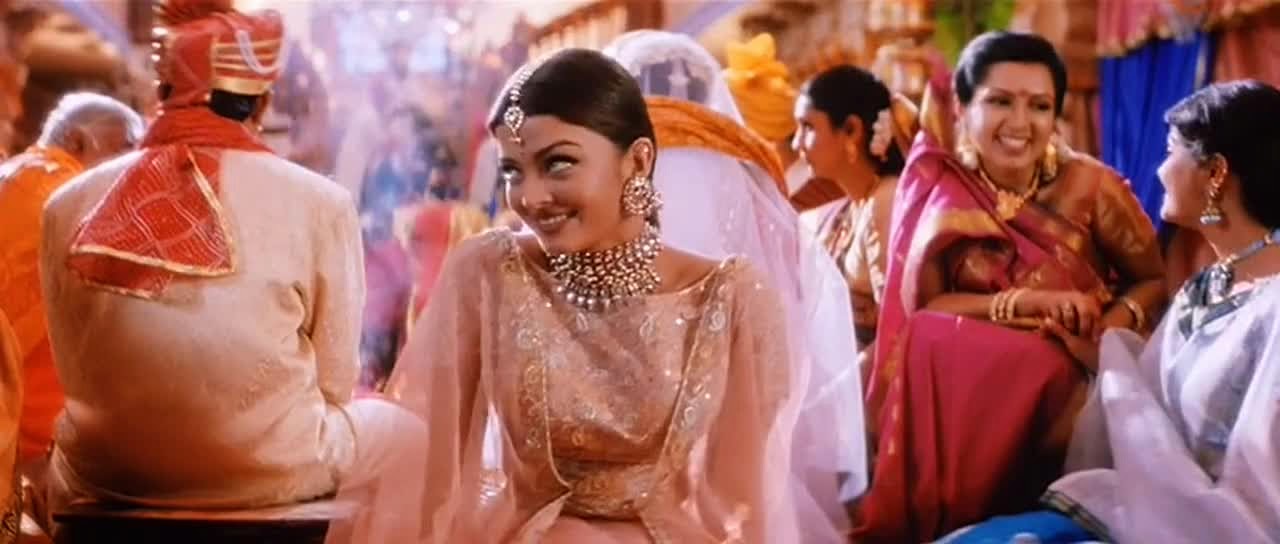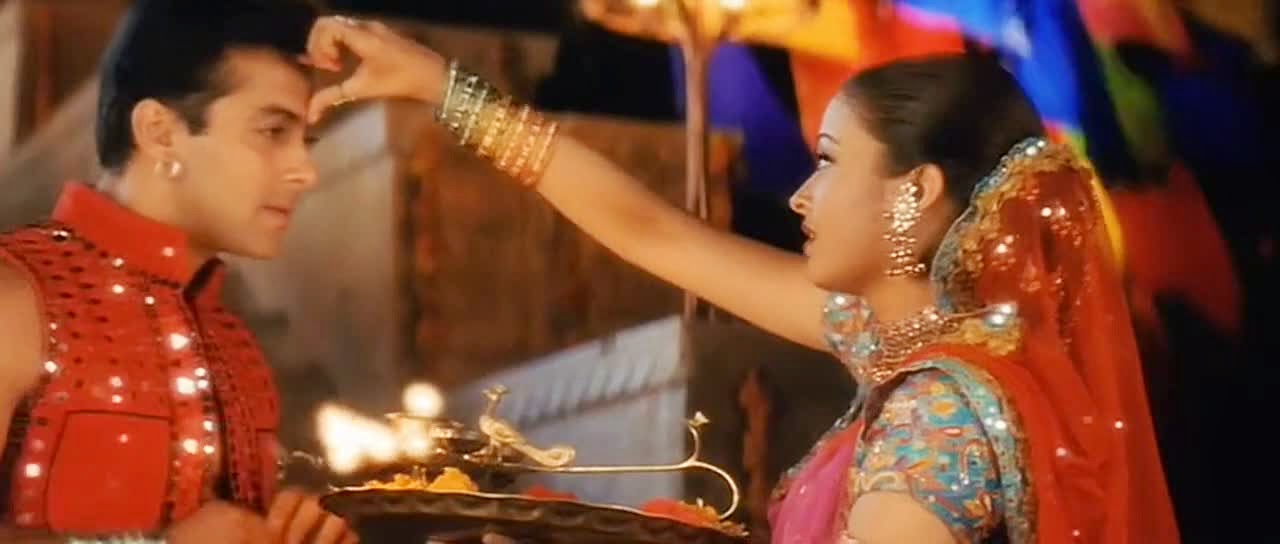I had not planned to write this post as I had something else that I had researched, and on that topic, I had some thoughts that I hoped I will write this week. But something happened yesterday that made me postpone that post for some other time. Yesterday, I started listening to the terrific song Manmohini from Hum Dil De Chuke Sanam as it was playing in my head for the last few days. And then, I started listening (and watching) to all the other songs in the film. Something struck me while listening, and I started observing a similar pattern throughout its songs. Sanjay Leela Bhansali considers V.Shantaram as his idol. In numerous interviews, Bhansali has said that he tries to incorporate elements from V.Shantaram's films in his own films. Whether it is Ae Malik Tere Bandey Hum from Do Aankhen Baraah Haath sung by Gulaab ji (Rani Mukerji) in Saawariya, or countless peacock motifs inspired by Jhanak Jhanak Payal Baaje in Ram Leela, Shantaram's influence is visible in a Bhansali film. I had written in my post on Ram Leela that the film was brimming with peacocks — the songs, the lyrics, the art direction, the characters — some or the other things were inspired by India's national bird in the film. I had never noticed but this same pattern is repeated in Hum Dil De Chuke Sanam. As I always say, I did not know how to watch films (perhaps I still do not know). It is after reading and constantly thinking and observing even the smallest details that I have begun to understand some aspects. There is still a long way to go but when I saw this peacock pattern in the Hum Dil De Chuke Sanam's songs as well, I felt a bit of amazement at myself why I had not seen it before. It is present everywhere in the film and considering it is one of my favorite films, how could I miss it in the first place.

In Albela Sajan, we see a peacock near the pond where Sameer (Salman Khan) is sunbathing. Then, a few moments later, Nandini (Aishwarya Rai) starts playing with a peacock. The lamps in Nandini's father's room and in Nandini's own room have peacocks on them. The handicraft piece on her room's door has peacocks embroidered on it. Nandini's room has peacock feathers and peacock-shaped brass statues. In Aankhon Ki Gustaakhiyaan, the same pattern is observed. We see peacocks on curtains, lamps, and walls. In fact, Nandini's dress has peacock booties all over. Then comes Nimbooda. What is worth noting is that as soon as the song begins, Nandini does some arm movements that are reminiscent of a peacock flapping its wings. Later, at one point in the same song, some men even say hurrr as if trying to shoo away a bird. In Nandini's parents and daadi's room, there are again peacock-shaped brass lamps. In Chand Chupa Baadal Me, there is a line that says, "Pyaar to naam hai, sabra ka humdam, wo bhala bolo kaise karen hum, sawan ki raah jaise dekhe mor hai, he rehne bhi." In Dholi Taro, yet again, we see that there are peacock lamps. Isn't this simply fascinating? Bhansali uses the same elements in Ram Leela. I guess I need to see the movie again to find more peacocks if these are the references in only its songs. Why are these included? Is that a tribute to V.Shantaram, or does a peacock hold a special meaning in Bhansali's life that he makes it a point to include them in some way or the other? I tried to research the reasons when I wrote on Ram Leela, but I am not sure if the symbolism of the peacock — beauty, love, pride, purity — is the only purpose. I, sometimes, wonder if I have something like this in me. Why do people make films? Yes, money is an obvious reason but what drives this passion for telling stories in a unique way. Why did Bhansali include such tiny details that I guess hardly anyone noticed or even cared about? Does this concept of taking inspiration and giving a tribute bring them closer to their idols? If I meet Bhansali someday (and I really hope I get that chance), I know he loves peacocks, so, does film-making help them understand their own self better? Does this creativity bring them a sense of joy that takes them closer to some metaphysical concept of consciousness? Is that why some people really want to get high — to experience that feeling of ultimate exhilaration? Perhaps, it is something that only our auteur and genius filmmaker can guide us to some answers.
In addition to these alluring peacocks, there is another glorious depiction which my staid brain is still trying to find some probable elucidation. At one earlier point in the film, Nandini is asked to vacate her room for Sameer. Her family members make fun of her by saying all that she has to do is take out only three things — some yellow flowers, the chandelier, and her diary. I had written earlier in this post about the chandelier. Nandini and Sameer meet for the very first time at the chandelier. Nandini is shown lighting the chandelier with a candle and that was actually a symbol of the beginning of their love. When Sameer is leaving, Nandini runs, her dupatta catches fire, the chandelier shakes, and eventually, Nandini breaks the chandelier as if their love has ended. What I want to talk about are the yellow flowers. Her room is full of yellow flowers. When Sameer leaves, he remembers Nandini by these yellow flowers; one of them which he even keeps with himself. There are yellow flowers in Nandini and Vanraj's (Ajay Devgan) hotel room in Italy; nothing extraordinary, as flowers are quite commonplace in hotels. But what struck me is that the scene where Nandini is shot is filled with yellow flowers. Was this resplendence of yellow flowers a sublime sign of Vanraj's abundant and infinite love for Nandini, who loves these flowers? Nandini is dressed in a lovely green saree whose color matches the stem of the flowers. Is her face, then, like one of those yellow flowers? Does the presence of these numerous yellow flowers in some way refers to the limitlessness of Vanraj's love as compared to the delicateness of a single flower that Sameer carries, that is perhaps referring to the delicate first love of Nandini and Sameer? Nandini while meeting Sameer in the end says, "Tumne mujhe pyaar karna sikhaya, pyaar nibhana maine Vanraj se seekha hai?" Do these yellow flowers symbolize that? I am still trying to find answers. Even if these do not mean anything, the scene is gorgeously shot.
I know I think too much but somehow, I can always find something that convinces me that, perhaps, what I am simply conjecturing might be true. A short post, but I have so many more things to write about. More later. Old posts on Ram Leela here and on Hum Dil De Chuke Sanam here. And, putting the pictures of the peacocks and the yellow flowers below.
Vanraj's infinite love
Peacock near the pool
Nandini playing with a peacock
Peacock lamps
Peacock lamps
Peacock feathers
Peacocks on the door handicraft
Peacock brass statue
Peacock behind the curtain
Peacock lamps
Peacocks on Nandini's dress
Peacock painting
Peacock painting
Nandini dances like a peacock
Peacock lamps on the bed
Peacock lamps on the swing
Sawan ki raah jaise dekhe mor hai
Peacock on saree
Vanraj's abundant love
Sameer's delicate love
Yellow flowers
Nandini's room with yellow flowers
More later.
Dialogue of the day:
"Teri yaadon ke saaye me guzaregi ye zindagi,
Us khuda ke baad to pooja hogi bas teri,
Chahe jo maang lo, sab tumhara hai."
— Hum Dil De Chuke Sanam























Hey nice post.. am from Seattle too :) lets connect !
ReplyDeleteVery fond of this movie! Super blog
ReplyDeleteThis is very interesting, thanks for posting.
ReplyDeleteThis is very interesting, thanks for posting.
ReplyDeleteWOW! I'm Amazed at your observation skills. MashaAllah! 😍
ReplyDeleteWell written. Hum dil de was tribute to v shantaram devdas to bimal roy ram leela to ketan mehta mirch masala saawariya to raj kapoor bajirao mastani to k asif modern day mughleazam..all his favourite makers Khamoshi black guzaarish is a mystery. Write about padmavat also.
ReplyDeleteWhat a beauty blog, seriously.
ReplyDelete